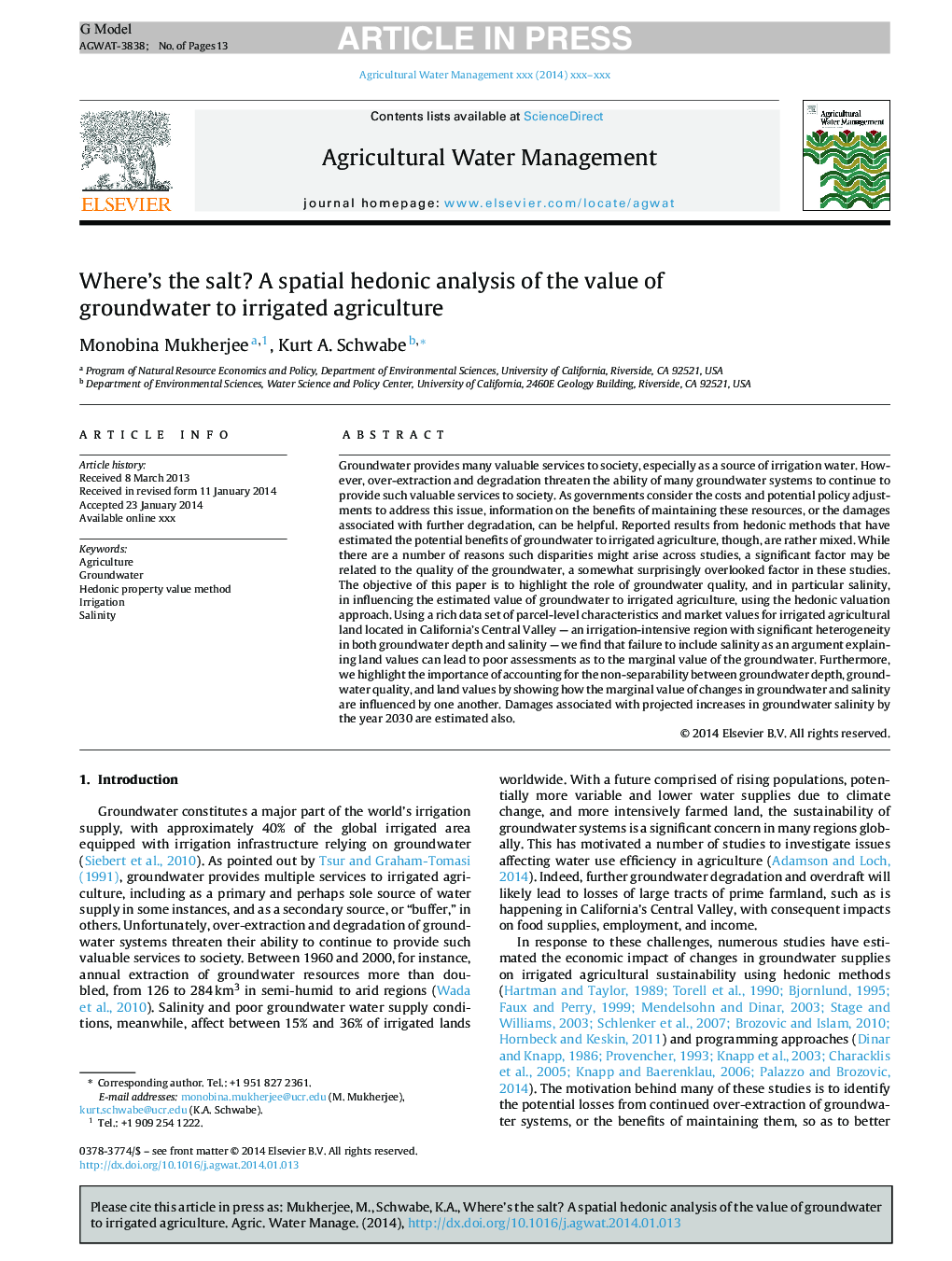| کد مقاله | کد نشریه | سال انتشار | مقاله انگلیسی | نسخه تمام متن |
|---|---|---|---|---|
| 6363908 | 1622934 | 2014 | 13 صفحه PDF | دانلود رایگان |
عنوان انگلیسی مقاله ISI
Where's the salt? A spatial hedonic analysis of the value of groundwater to irrigated agriculture
ترجمه فارسی عنوان
نمک کجاست؟ تجزیه و تحلیل فضایی هدیونی ارزش آبهای زیرزمینی برای کشاورزی آبیاری
دانلود مقاله + سفارش ترجمه
دانلود مقاله ISI انگلیسی
رایگان برای ایرانیان
ترجمه چکیده
آب های زیرزمینی بسیاری از خدمات ارزشمند را به جامعه ارائه می دهد، به ویژه به عنوان منبع آب آبیاری. با این حال، بیش از حد استخراج و تخریب توانایی بسیاری از سیستم های آب زیرزمینی را برای ارائه چنین خدمات ارزشمند به جامعه تهدید می کند. با توجه به این که دولت ها هزینه ها و تنظیمات سیاست بالقوه را برای رسیدگی به این مسئله در نظر می گیرند، اطلاعات در مورد مزایای نگهداری این منابع و یا خسارات ناشی از تخریب بیشتر می تواند مفید باشد. هرچند که نتایج گزارش شده از روش های هودینی که مزایای بالقوه آب های زیرزمینی را برای کشاورزی آبیاری برآورد می کنند، نسبتا مخلوط هستند. در حالی که دلایل متعددی وجود دارد که ممکن است این تفاوت ها در سراسر مطالعات رخ دهد، یک عامل قابل توجه می تواند به کیفیت آب های زیرزمینی مربوط شود، که در این مطالعات، تا حدی شگفت آور نادیده گرفته شده است. هدف از این مقاله، تعیین نقش کیفیت آبهای زیرزمینی و شوری خاص در تأثیرگذاری بر ارزش تخمینی آبهای زیرزمینی برای کشاورزی آب آشامیدنی با استفاده از رویکرد ارزیابی هودینی است. با استفاده از یک مجموعه داده های غنی از ویژگی های سطح بسته و ارزش بازار برای زمین های کشاورزی آبیاری واقع در دره مرکزی کالیفرنیا - منطقه آبیاری شدید با ناهمگونی قابل توجه در عمق و شوری آب های زیرزمینی - ما می بینیم که عدم شوری به عنوان استدلال توضیح زمین ارزش ها می توانند منجر به ارزیابی های ضعیف نسبت به ارزش حاشیه آب های زیرزمینی شود. علاوه بر این، ما اهمیت حسابداری برای عدم جدایی بین عمق آب زیرزمینی، کیفیت آبهای زیرزمینی و ارزش زمین را با نشان دادن اینکه چگونه ارزش حاشیهای تغییرات در آبهای زیرزمینی و شوری تحت تاثیر یکدیگر قرار می گیرند، برجسته می کنیم. خسارات ناشی از افزایش پیش بینی شده شوری آب های زیرزمینی تا سال 2030 برآورد شده است.
موضوعات مرتبط
علوم زیستی و بیوفناوری
علوم کشاورزی و بیولوژیک
علوم زراعت و اصلاح نباتات
چکیده انگلیسی
Groundwater provides many valuable services to society, especially as a source of irrigation water. However, over-extraction and degradation threaten the ability of many groundwater systems to continue to provide such valuable services to society. As governments consider the costs and potential policy adjustments to address this issue, information on the benefits of maintaining these resources, or the damages associated with further degradation, can be helpful. Reported results from hedonic methods that have estimated the potential benefits of groundwater to irrigated agriculture, though, are rather mixed. While there are a number of reasons such disparities might arise across studies, a significant factor may be related to the quality of the groundwater, a somewhat surprisingly overlooked factor in these studies. The objective of this paper is to highlight the role of groundwater quality, and in particular salinity, in influencing the estimated value of groundwater to irrigated agriculture, using the hedonic valuation approach. Using a rich data set of parcel-level characteristics and market values for irrigated agricultural land located in California's Central Valley - an irrigation-intensive region with significant heterogeneity in both groundwater depth and salinity - we find that failure to include salinity as an argument explaining land values can lead to poor assessments as to the marginal value of the groundwater. Furthermore, we highlight the importance of accounting for the non-separability between groundwater depth, groundwater quality, and land values by showing how the marginal value of changes in groundwater and salinity are influenced by one another. Damages associated with projected increases in groundwater salinity by the year 2030 are estimated also.
ناشر
Database: Elsevier - ScienceDirect (ساینس دایرکت)
Journal: Agricultural Water Management - Volume 145, November 2014, Pages 110-122
Journal: Agricultural Water Management - Volume 145, November 2014, Pages 110-122
نویسندگان
Monobina Mukherjee, Kurt A. Schwabe,
